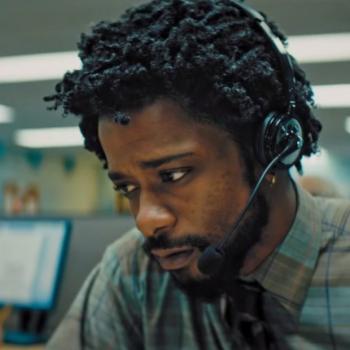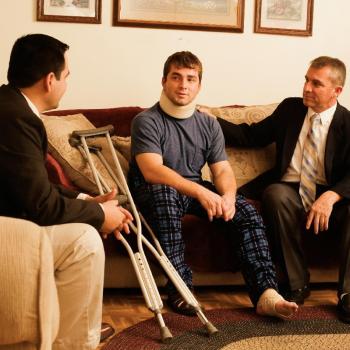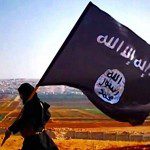About a week ago, I decided to write my next post on a recurrent popular representation of the Mormons that we didn’t see much of during Mitt Romney’s 2012 presidential campaign: the image of Mormon violence. I was going to talk about why I think this image didn’t surface during the recent Mormon moment, and whether or not I think it has a future now that the moment is over. But since last Friday, we have all watched in horror as unspeakable violence and its aftereffects have unfolded in Newtown, Connecticut, brought simultaneously into our homes in real time on 24-hour cable news outlets, online news media, and social networking sites.
I don’t want to think about violence right now—real or imagined—or distance myself from it with objective academic arguments. So that left me wondering, what do I want to think about and write about? What aspect of my research can I discuss, in this moment of national grief, that doesn’t feel utterly trivial and irrelevant—not to mention disrespectful?
I decided to focus this post on the major recurrent theme in positive American representations of the Latter-day Saints across the last century. For at least the last one hundred years, in troubled times when Americans have sought to stress national unity over internal differences, representations of the Saints have highlighted Mormon solidarity and community support. In fact, at times, the Saints’ sense of community has been held up as a model to be followed by the nation.
War time provides the most obvious examples. The news media first regularly called members of the LDS Church “American Mormons”—thus implicitly identifying their religion as American—during the Mexican Revolution (c. 1910–1920). When rebels attacked Mormon settlements in northern Mexico, and eventually crossed the border to attack ranches and towns in the United States, the nation’s newspapers rallied behind the brave “American Mormons” defending the neat and orderly towns that their hard work and ingenuity had planted in the Mexican desert. When, immediately on the heels of the Mexican conflict, World War I focused Americans’ attention on Europe, the Saints were praised not just for defending their own, but for contributing to the national war effort: individuals were celebrated for enlisting to fight; the Church was congratulated for voluntarily donating its grain stores to the federal government. [1]
A scant two decades later during World War II, Senator Elbert Thomas earned national praise using the language skills he developed serving a 5-year Mormon mission in Japan to play America’s own Tokyo Rose, broadcasting warnings to the Japanese in their own language about the dire consequences of war with the United States. Out of respect for the many Saints serving the nation, the Army canceled its order for a free edition of Zane Grey’s classic western novel, The Riders of the Purple Sage, meant for the troops, when a proofreader pointed out that the book was “a bitter attack on Mormons.” [2] And at the first official memorial service held after the attack on Pearl Harbor, newspapers reported that the only Christian prayer was offered by Keawe Kapellela, a native Hawaiian Mormon missionary. The Mormons weren’t just being praised for their service to the nation it seems, but for their participation in its Judeo-Christian faith and practice. [3]
This greater openness was no doubt influenced by a number of factors. By the time of World War II, the Saints’ 19th-century practice of polygamy was fading into historical memory, as was the theocratic fusion of church and government that had characterized Utah before it was granted statehood in 1896. The Church and its members were, as Armand Mauss has shown, eager in this period to accommodate to the wider American culture. [4] And, during the Great Depression of the 1930s, the Saints had demonstrated a flair for hard work and mutual support within their community. Americans praised Church-organized and member-supported programs that provided work, food, and basic necessities to Mormon families in an effort to get Mormons off the dole. Both the Church and the national media held up the Saints’ Church Welfare Program to other Americans as a model of how a community could—and should—take care of its own. [5]
Perhaps my favorite rose-colored images of the Mormons (it is important to remember that I am, after all, dealing here in representations that generally do not fully reflect realities) are those that were current in the 1950s and ‘60s. As the nation sought to present a united front to its Cold War enemies and celebrate its heroic taming of the wild west in the 19th century, early Mormon settlers in Utah were reimagined as pioneers and cowboys. As 20th-century Americans sought to craft a unified Judeo-Christian community, America’s history of anti-Mormon intolerance was lamented and softened in books and films that presented the Latter-day Saints as partners in the project of Manifest Destiny, claiming and civilizing the West. John Ford’s lovely film Wagon Master followed the journey of a group of Mormons and a pair of Gentile horse traders who agreed to guide them through the bleak deserts of southern Utah, where the Mormons planned to build a new settlement. Ford’s Mormons were real people. A few were self-righteous and occasionally mean, but most were good-natured folks who cussed when they were angry, prayed when they needed help, and gave what little they could to those in need—regardless of religious affiliation. After sharing the dangers and privations of the trail, the young Gentiles led the party of Saints to the right place and stuck around to help their new friends create a home. [6]
In his 1955 family memoir Papa Married a Mormon, John D. Fitzgerald (also the author of The Great Brain series of children’s books) painted a similar picture of cooperation on the rough frontier. He described a town where the Mormons who settled the place and the Gentile miners and businessmen who followed worked together to carve their livings—and a community—out of the desert. Fitzgerald’s Catholic Papa became a cornerstone of that community by deciding, upon first moving west, that he would “judge men by the contribution they made to science, culture, social and economic progress, tolerance, patriotism, spiritual leadership, and their regard for the well-being of their fellow-men.” Not by what religion they followed. [7]
More recently, images of the Saints helping not just themselves, but their non-Mormon neighbors have become an important part of the Mormon public image. Helen Whitney’s 2007 documentary The Mormons, produced for Frontline and American Experience on PBS, featured a segment on “Reaching Out to the Wider World.” In particular, the film focused on LDS involvement in the recovery efforts after Hurricane Katrina devastated America’s Gulf Coast in 2005. Residents of New Orleans and southern Louisiana talked about the Mormon volunteers—“in their yellow t-shirts”—who arrived in the region with food, supplies, and people to help. The Mormons were, according to one resident, on the ground in his neighborhood before any government agencies. “Before the storm,” he told the camera,
I’d had Mormons knock on my door just like everybody else probably. And so the object was to try and get rid of ‘em as fast as possible. You know just, “Go away. Not interested. Don’t wanna hear what you have to say.” After the storm—little bit different now. They’re part of my family now. Always will be. They—they got into my heart. They’ll never stand on my doorstep again without being invited into my house. [8]
Even the Broadway hit The Book of Mormon, which in many ways lampoons and even belittles the Saints, celebrates Mormons for their dedication to making the wider world—not just their own corners of it—a better place. [9]
As I often say of my work on non-Mormon representations of the Latter-day Saints, these popular images don’t give us anything like a clear picture of the Mormons. But they do speak volumes about how Americans imagine themselves as a national community. The characteristics emphasized in different images demonstrate what beliefs and behaviors many Americans reject—and what values they prize. In these positive representations of the Latter-day Saints, we see Americans yearning for a sense of community, of mutual care, and even toleration, respect, and loving-kindness that cross—or simply refuse to acknowledge—the identity markers that so often divide us.
In the wake of last Friday’s senseless violence, that’s what I choose to think about this week.
[1] See, for example, “Mormons Give Up Wheat: Church Turns over Reserve of 250,000 Barrels to Government,” New York Times, June 12, 1918.
[2] William M. Leary, Jr., “Books, Soldiers and Censorship During the Second World War,” American Quarterly, Vol. 20, No. 2, Part 1 (Summer, 1968), 238.
[3] “Honolulu’s Tribute Is Paid to War Dead: Citizens Join in Memorial Service at Navy Men’s Graves,” New York Times, January 2, 1942; and “Honolulu Marks Memorial Day for Raid Victims: Services at the Graves; Churches Filled,” Chicago Daily Tribune, January 2, 1942, an extended version of the same article published by The New York Times.
[4] The Angel and the Beehive: The Mormon Struggle with Assimilation (Urbana, IL: University of Illinois Press, 1994), esp. “Part II: Mormons as an Assimilated American Subculture.”
[5] See, for example, discussion in Jan Shipps, Sojourner in the Promised Land: Forty Years among the Mormons (Urbana, IL: University of Illinois Press, 2000), 68, 127; Chiung Hwan Chen and Ethan Yorgason, “‘Those Amazing Mormons’: The Media’s Construction of the Latter-day Saints as a Model Minority,” Dialogue Vol. 32, No. 2 (Summer 1999), esp. 114–18.
[6] USA: RKO Pictures, 1950.
[7] Fitzgerald, Papa Married a Mormon (Englewood Cliffs, NJ: Prentice-Hall, 1955), 51.
[8] The Mormons, Part II, Helen Whitney, dir. (USA, 2007). Available online at http://www.pbs.org/mormons/view/.
[9] The Book of Mormon, book, music, and lyrics by Trey Parker, Robert Lopez, and Matt Stone, 2011–.











